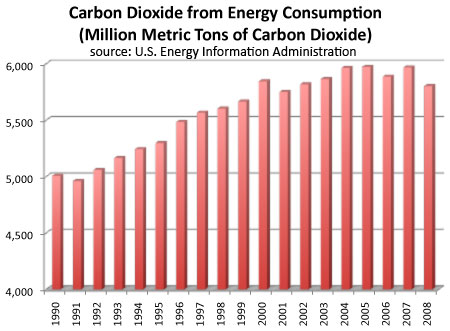I am on the U.S. Energy Information Administration’s (EIA) e-mailing list. It is the study and statistical section of the U.S. Department of Energy. They also have a webpage that includes some informative summaries for reasonable well informed non-experts, along with links for further inquiry. It is the place I usually start when I am trying to understand any energy related issue.
Overtaken by Events
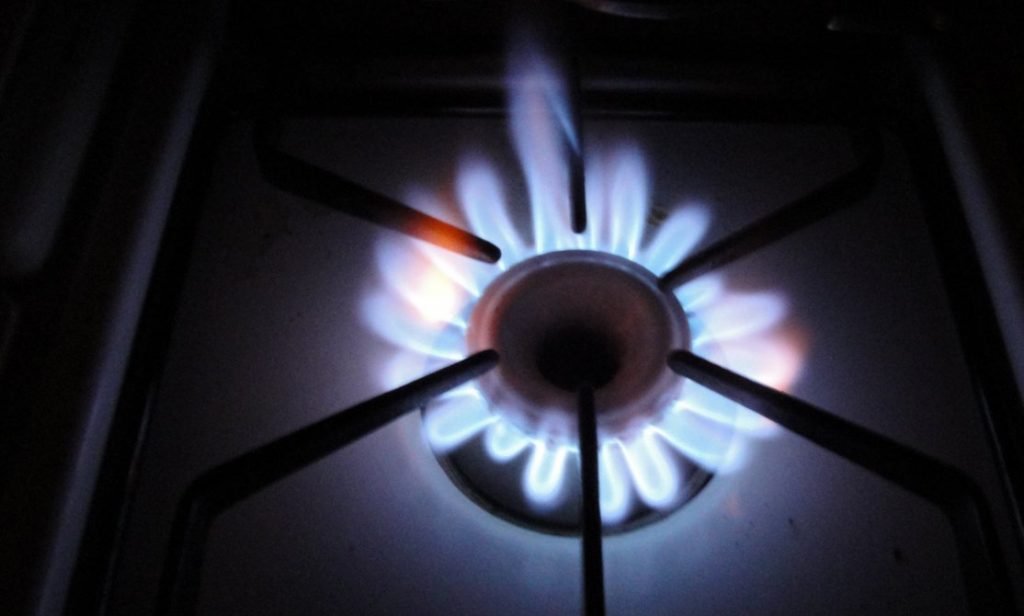
We rarely solve big problems; we just go beyond them, usually by redefining our goals and priorities and often by employing knowledge and technologies that were unavailable when the problem was initially defined. In other words, our vision of solutions for the future is often limited because those solutions have not been invented yet. We have a phase “overtaken by events” (OBE’D). It refers to facts, ideas or plans that are invalidated by subsequent events. Most problems are not really solved; they are just OBE’D.
Stuff happens sometimes for no reason we can understand
The future is uncertain by definition, but we have learned to manage risk. Our increasing ability to identify and manage risk is one of the too often overlooked foundations of our complex modern civilization but we never eliminate it and there are many situations where there is so much uncertainty that we cannot even properly assess the risk, i.e. figure out the odds. (I read a couple good books on this. I recommend “the Black Swan” & “Against the Gods.”) This is what drives people crazy. It seems counter intuitive to some, who seem to think that if we could solve our big problems if just worked hard enough and planned well enough. We things go badly wrong, they look to blame someone. Well, sometimes we just have uncertainty. Shit happens in ways nobody could have reasonably predicted and sometimes in ways nobody could have predicted at all.
Not all of this is bad, however. In fact it is mostly good. There are upside and downside surprises but in the long run the upside surprises are more important. Why? Even if the ups and downs are distributed randomly, we can apply human intelligence to adapt to them. Within broad parameters, the quality of our lives depends less on the good or bad luck we experience than on the responses we make to what comes along. We have to use an iterative approach that learns from experience and changes responses to changing circumstances.
Einstein was right when he said that we cannot solve problems with the same kind of thinking that we used when we created them.
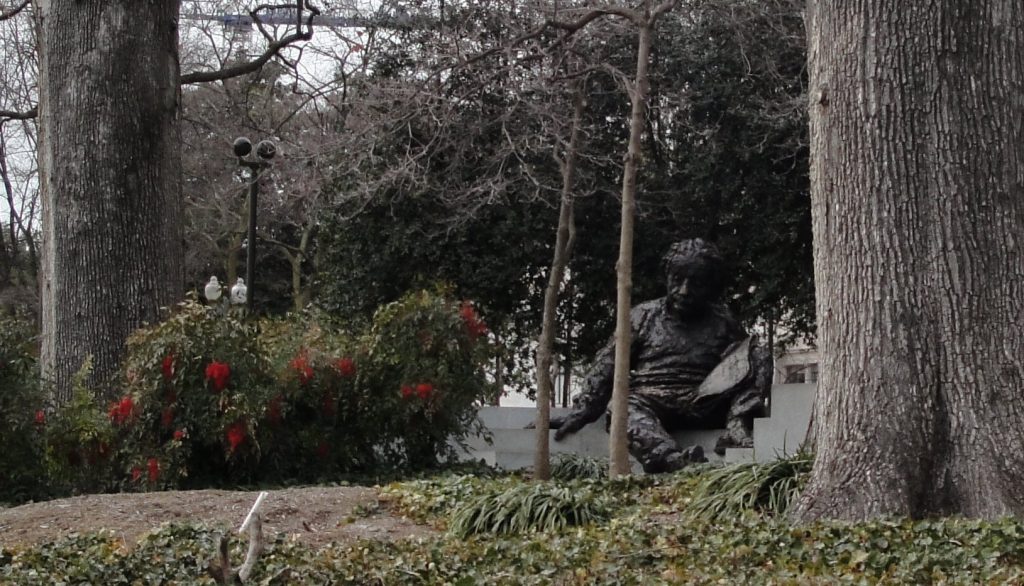
O Fortuna velut Luna
The best system is not one that plans in detail for all the challenges but rather one that is robust enough to adapt to changing conditions and exploit opportunities, one that embraces the statistical nature of the future and takes advantage of it. We need more of a planning process than a precise plan. We cannot anticipate all the events but we can have processes in place that can recover from setback to adapt to changes. I think of it like a tool box and portfolio. In an uncertain world, you have to diversity and empower those closest to evolving events. This is how markets work, BTW.
This is a harder sell than the dishonest or self-deceptive statement that you have anticipated and planned for all the eventualities. Most people crave certainty and they love those who claim to have it, even when they know or should know it is bogus comfort. We make systematic errors in the direction of imposing patterns of certainty where none exist. That is why we think clouds look like Snoopy or Albert Einstein. There is even a five dollar word for it “apophenia”.
Anyway the simple advice is to find or create adaptive robust systems that can survive downside shocks and move quickly to exploit upside opportunities, all the time understanding that the Lady Fortune’s Wheel never stops turning. (BTW I am thinking of this in terms of Boethius, not Pat Sajack and Vanna White) It can pull you up and down and some big things can come up pretty fast.
Now you’re cooking with gas
One upside surprise that is a real game-changer is the recent technological advance that allows us to get natural gas from shale deposits. In the last couple of years, we have made available natural gas deposits with more than the energy potential of all the oil in Arabia. A solution that was unavailable and largely unforeseen five years ago will change all our lives … soon. I wrote about this a couple of months ago as I drove through the Pennsylvanian coal – and now natural gas – country.
Natural gas is the perfect partner for wind energy, since gas plants can be turned on and off relatively easily. Wind is very good when it is blowing but it can cut off quickly. In other words, it is unreliable w/o backup. Nature gas is the backup.
Natural gas can help us squeeze oil out of our transportation network. According to the linked article, “the chief obstacle to developing a natural gas infrastructure capable of supplying service stations and highway rest stops is regulatory. If that is removed—and here we do need government action—we could expect to see trucks, buses, and cars running on natural gas in a relatively short period of time. The reduction in greenhouse gas emissions would be considerable.”
This new energy future will not only help us free ourselves from the despots who control most of the world’s oil reserves (it seems like kind of a divine joke that most of the world’s easy to get oil is under such regimes) but it will also reduce greenhouse gas emissions w/o the draconian measures contemplated just a short time ago. Natural gas is cleaner than oil and much cleaner than coal in terms of pollution and in terms of CO2.
So a problem that was intractable with the conditions and technology of 2005 could be party solved in ways that nobody really anticipated. But we have to use our intelligence to make an upside surprise into good fortune … before it is OBE’D or Fortune’s wheel takes another turn.
Negotiation 101 and Climate Change
“When you say you agree to a thing in principle you mean that you have not the slightest intention of carrying it out in practice.”* I have limited confidence in the efficacy of big global agreements, but I understand the usefulness of participating and we hope our team will be very forthcoming and aggressive in the COP 15 climate talks.
Forget Kyoto
The Clinton Administration never had any intention of implementing Kyoto. The Senate rejected it 95-0 before even being asked to ratify it. This was a unanimously bipartisan rejection of the climate treaty. Kyoto was dead on arrival, as the saying goes and it was indeed a seriously flawed agreement but Clinton was clever. He understood the dynamics of the public relations around climate change. Nobody really intended to carry out the terms of the treaty beyond the extent to which it was convenient. Most of the climate lobby was perfectly content if the U.S. went along rhetorically. Most of the major players were going along with the mendacious program. Bush didn’t understand how to play that deceptive game well enough and openly rejected the agreement & the U.S. got eight years of international crap as a result.
Take credit for what will happen anyway
Kyoto was meaningless. Developing countries got a free ride on the misplaced guilt of the more productive and hence more energy consuming nations (energy consumption is closely related to output). The former Soviet Empire was in the process of shutting down the horribly polluting – and without strong state protection – unprofitable industries built up during the benighted communist era. Countries in both these camps knew that nothing much would be asked of them and they might even be able to make a little money selling carbon they would not have produced anyway. The Russians were in the now even more enviable position of having been so horribly dirty and inefficient that any approach to normal would be rewarded with unearned credits and cash.
BTW – Russian carbon credits are one of the reasons ostensible carbon reductions in Europe were so cheap and ineffective.The Russians are now lining up to milk what they can out of Copenhagen.
Our European friends also came to the game with a few aces up their sleeves and a lot reductions already cooked into the pie when they signed on to Kyoto. In the British Midlands, they were in the process of converting from dirty coal to much cleaner and less carbon intensive natural gas. The Germans had recently acquired the outdated industry of communist-East Germany. They were shutting down these inefficient and very polluting industries anyway. It was sort of like a cash for clunker industries program.
The fall of communism in Eastern Europe was a significant ecological benefit all around. Just bringing industries up to non-communist standards resulted in a big reduction of all sorts of pollution. Beyond all that, they understood that Europe’s generally slower rate of economic growth would slow demand for new uses of carbon.
The U.S., in contrast, didn’t have any big shutdowns on the way and our economy was growing about twice as fast as those in continental Europe which would mean a growing need for energy.
Progress is on the way; revel in it and don’t sell it cheap
We are now in a better position in relation to many others. We can plausibly promise real reduction in CO2 emissions, but it is very important how we sell reductions. You don’t give things away in negotiations because you get no credit in the international community if you just do the right thing w/o making a big deal about it. Multilateral negotiations are a kind of kabuki play. You have to scream and grimace at the proper times or else nobody pays attention. You have to call attention and claim credit for good things that just happen. You know that you will be blamed for the bad things.
The free market is remarkably adaptive. When the price of gas rose in 2006, Americans used less energy and emissions of CO2 dropped. This is the only time this happened in a major country during a time of robust economic growth. Did we get any credit? Did anybody even notice? I had to look hard to find it in the media. WITHOUT the hyperbolic rhetoric you don’t even get credit for what you REALLY do. WITH rhetoric you can even get credit for things that just happen even if you do nothing. It takes a little dose of hypocrisy to make the world go around.
Now we’re cooking with gas
It gets better. We will soon be able to reduce carbon emissions w/o working up too much of a sweat. Technological advances in only the last few years have made available vast amounts of natural gas within the U.S. Our recoverable reserves have gone up by 39% in the last two years alone and gas is getting very cheap. As the economics of gas improve, we will switch from coal and oil, which emit much more CO2, to gas in many situations. This will reduce our emissions.
Natural gas is also abundant in areas of the U.S. much in need of jobs and investments.
There is an even better good news story. Last year the U.S. displaced Germany as the world’s largest producer of wind energy. Wind is still no big deal as a % of energy consumption, but the trend is continuing and abundant cheap natural gas can play a role. Wind is unreliable. You have to have a back up capacity. Gas is perfect for this. Unlike a coal plant, a gas generator can be easily turned on and off. On windy days, we would get electricity from wind. When the wind wasn’t blowing, gas would fire up to fill the demand.
Other alternatives plus better quality nuclear power is also coming on line. Match this with the generally slower economic growth we expect to suffer during the next couple of years (there is a silver lining to every black cloud) and you see that U.S. emission growth will slow and we may even have some actual drops. If you look at the chart nearby, you will see that the trend started down in 2006. We expect another huge drop of 5% in 2009. Notice from the chart that our emissions were a bit lower in 2008 than they were in 2000, w/o the benefit of Kyoto, BTW.
That means we can promise AND the United States can deliver. Delivering is important, but it is the promising that is the key to UN success. You need a lot of sound and fury in the international climate game. If we just deliver, we get no credit (cf. carbon reduction under GW Bush). In the international negotiating arena, especially international public opinion, what you say and how loudly & passionately you say it is at least as important as what you do.
We don’t have to take it anymore
The U.S. also needs to be in a stronger “moral” position to resist unreasonable demands by less developed countries. In fact, we can turn the tables on them. They always said, or at least implied that they were waiting for us, that if we (the U.S.) reduce our emissions they would do likewise. We are now holding the cards we need to call their bluff. We doubt most others will actually come through, but it will at least take some of the wind out of their sails when they make unreasonable demands on us. With our emissions dropping and those from places like China (the world’s largest CO2 emitter since 2006) and other developing countries on the rise, we can throw some of the stink in the other direction for a change.
The U.S. will be a leader in the effective use to climate change technologies
This is potentially a real game changer. With President Obama’s smooth rhetoric and proven ability to promise “change we can believe in” hitched to the real potential of the American market to take advantage of favorable energy trends and the unexpected bonanza of natural gas in the short term, we can cram a sock in the anti-American rhetoric on this topic. Yes we can.
Go boldly; no need to apologize
So let’s play hardball by “playing nice.” No need to apologize or send too much money to contribute to kleopocracies in developing some countries who use the poverty of their people and bad weather as bargaining chips. Instead, shift our weight and do a little international style jujitsu. We have little to lose, since we are on track to succeed anyway in reducing our emissions relative to the rest of the world, if we use the cheap natural gas we have found and ride the wave of innovation already coming our way. But none of it will count unless we make a big deal of promising. Posturing, promises & procrastination, that is how they roll at these kinds of international conferences. The rules of the game do not require and do not always even encourage actual success anyway, but we can both talk and do in this case.
Let’s do it and let’s also be seen to be doing it. It will benefit neither the environment nor us to allow another Kyoto to be hung around our necks. But with the proper nudge, maybe something can actually get done … even really about the environment maybe.
* The saying is attributed to Otto Von Bismarck
Yesterday’s Solutions are Today’s Problems
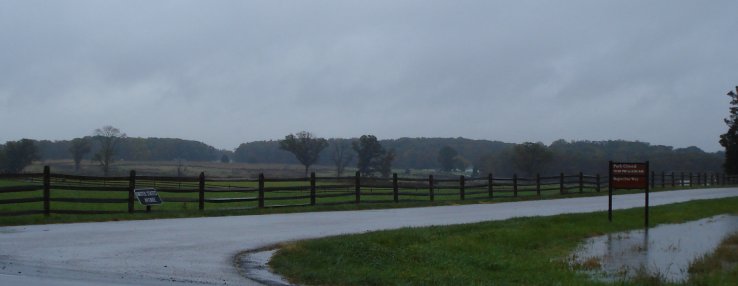
We are starting to notice the remarkable, game changing development in energy. Scientists have discovered a new way to get natural gas out of shale. They call it hydraulic-fracturing. And there is a lot of potential. This new technique has increased American gas reserves by something like 39% in the last couple of years. Experts estimate that we have as much usable gas in the U.S. as the Saudis have oil and if only half of our coal powered plants converted to cleaner burning natural gas we could easily reach our greenhouse gas reduction goals.
Gas is cleaner than oil and much cleaner than coal, both in terms of actual pollution and in terms of greenhouse gases such as CO2. Another important consideration is that WE have our own vast new supplies of gas. Most exportable oil is under corrupt, unfriendly or unstable countries. It is better not to send American money to some of these guys. Our gas, on the other hand, is in peaceful, pleasant American places like Pennsylvania, New York, Maryland and West Virginia. Many of these rural areas could use the jobs that domestic natural gas could bring.
I traveled though much of the area where the gas is when I drove from Syracuse to Virginia. It is the same area where we did a lot of coal mining. This is no coincidence. The same forces that turned Paleozoic plants into coal also made gas. The gas is trapped in shale formations and you can easily see how the roads were cut through the shale formations.
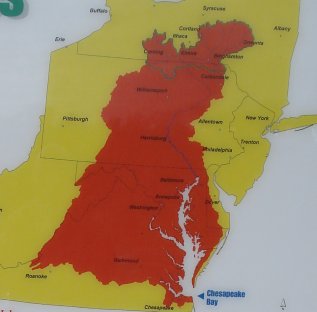
But I noticed something else about the geography of natural gas. It is also the geography of the Chesapeake Bay watershed and much of the water that isn’t running off into the Chesapeake flows into the Great Lakes. We worry about these bodies of water. While listening to local radio driving near Wilkes-Barre, PA I heard reports of firms extracting gas were asking permission to discharge water into the local streams. The HYDRO part of hydraulic-fracturing has to go somewhere. I don’t know the details of the process, nor do I know about the quality of the water discharge, but I do know that any discharge in large enough amounts is going to create disruptions in the local ecosystem, in this case the Chesapeake Bay watershed. Some people are already raising concerns. The process may turn out to be benign. It could even be beneficial if the water is clean, but we will have to think of this as a balancing among priorities.
Yesterday’s solutions are today’s problems and it follows that today’s solutions will be tomorrow’s problems. Abundant American natural gas will help free us from nasty foreign oil suppliers and help us reach climate change goals, no doubt at the cost of something in the future. This is not necessarily a failure of wisdom or judgment. It is an ordinary consequence of making choices, setting priorities and doing these things in the context of imperfect information. All these things are part of the definition of decision making.

Future critics with access to much more information as well as the experience of the past can easily attack earlier choices, but the comparison is usually unfair, as it is always unfair to compare hypothetical solutions with a real ones.
For now the smart move looks like going for the gas.
We’re Cooked

I went to a discussion of the costs of cap & trade. There were experts from Brookings, CBO, EPA, Energy Information Agency, the National Black Chamber of Commerce & Heritage Foundation, so we got the full spectrum of analysis. Lots of the assumptions were different and the ideology was contrasting, but they all came up with the same ballpark conclusions: cap & trade as it is now formulated in the House bill will cost a lot and probably will not work very well to control climate change.
As I have written many times before, I favor a broad carbon tax, which is why I could never run for office. I support cap & trade BECAUSE it is a type of carbon tax, albeit a less efficient and possibly corrupt way to do it, but it looks like there is enough inefficiency in corruption in the House bill to question it.
One flaw in the bill is that it includes almost nothing about nuclear power. In the long run, we will need to go with renewable power. In the medium run, there is no way to achieve the needed carbon reductions w/o nuclear power, which emits no greenhouse gas. Many environmentalists stupidly reject nuclear power. No form of power is w/o risks and costs, but if you believe that global warming is the existential threat some people say it is, doesn’t that almost certain risk of climate change trump the hypothetical risk of nuclear power? Not one person has died in the whole history of nuclear power in the U.S. Nobody was even seriously injured in the worst “disaster” in nuclear power history at Three Mile Island.
But a probably more serious problem is the phenomenal growth of emissions from developing countries such as China or India. China is the world’s leading emitter of CO2 and their emissions are growing rapidly. China adds the equivalent of two 500 megawatt coal fired plants EVERY WEEK. In one year it adds the equivalent of the whole British power network and by 2030 China alone could emit as much CO2 as the whole world does today. In other words, if everybody else cut to zero, it wouldn’t matter.
Talk is cheap, BTW. China has promised to cut emissions relative to GDP. That is good. But the U.S. has been cutting emissions relative to GDP since 1973 and in 2006, the U.S. was the only nation to cut emissions in absolute numbers during a time of economic growth.
So my conclusion is that we are cooked. We should think about adaptations to a warmer world. And we should be working on alternatives AND building nuclear power stations. Congress should go back to work and enact a true carbon tax that would get the government out of the business of picking winning and losing companies and technologies. Government has an abysmal record in doing this (consider the recent debacle re ethanol) and there is no reason to believe it has gotten any better. The current bill doesn’t inspire confidence. I like the idea of markets for environmental services in general. I was tentatively in favor of the climate bill. It has some good aspects, but it needs smarter leadership and some hard thinking.
BTW – the picture is Union Station from the window of Heritage Foundation, where the panel was held.
Changes Takes Time & Energy
Energy transitions take a lot of time and we won’t have that green energy anytime soon. That was the sobering message I heard at the lecture today by Vaclav Smil, from the University of Manitoba. I went to hear his talk, Energy Transition: the Time Factor, today at AEI.
Below are energy saving devices. I will be riding my real bike soon and I figure that I can walk anyplace that one of these little bikes can take me, but I think that Smartbike is a good idea.

It took nearly 400 years for England to covert from wood to coal. The U.S. didn’t get more energy from coal than from wood until 1884, and still has not really left the age of coal, since more than half of our electricity comes from coal fired thermal plants. Things take time for a variety of reasons.
Many enabling factor are necessary for an energy transformation to take place. A resource that cannot be brought to market is useless and sometimes transport is a limiting factor. That was the problem for natural gas. Oil and gas are often found together. In the old days, the oil could be shipped in tanks or barrels. There was often nothing they could do with the gas, so they just flared it. Gas couldn’t be transported until particular alloys and welding techniques developed that could move it under pressure and this didn’t happen until the 1930s. Even then, it took time to construct the network. W/o these things gas was useless even if it was essentially free at the well-head, demonstrating once again that a resource is not a resource until the technology is available to make it so.

Now You’re Cooking With Gas
Once the pipes were in place, gas became available around the country. In the 1940s, there was a phrase – “now you’re cooking with gas”– that implied you were up to date. Gas had been abundantly available for more than fifty years, but not accessible. Even then, it still took many years for most houses to get hooked up to gas. Some of our neighbors were still burning coal to heat their houses well into the 1960s.
Natural gas can now be piped long distances because of better compression engines. Back in the 1980s, President Reagan tried to block Soviet access to modern compressor technology. The got the engines in Europe so that today the cappuccino you buy in Italy is probably warmed with Russian natural gas.
BTW – recent technological improvements allow gas to be more easily shipped in tankers. Using more gas in place of oil requires less of a shift, so our energy future may be gassier.
BTW 2 – they talked re methane hydrates. I didn’t know what that was, so I looked it up. This is the link. This is evidently a big potential source of natural gas, although I saw something on the Science Channel talking re how melting of methane on the ocean bottom had caused the great extinction at the end of the Paleozoic Era, so I don’t know.
Below – this and the next picture are union representations near the White House. Unions are enthusiastic about getting jobs back and counting on the new energy infrastructure to help.
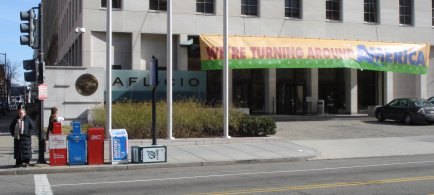
Professor Smil didn’t have much confidence in solar or wind power. These things, he said, have significant problem with availability (wind doesn’t always blow and he sun doesn’t shine at least half the time.) But the bigger challenge is transport. It is analogous to the problem with natural gas. The wind blows the strongest where there not many people and we don’t have the transmission lines to move the power. The same goes for surfaces where solar could be placed. Beyond that, both types of energy are small scale and locally intrusive. You will need lots of lines and lots of machines. Some of the people who love wind or solar in theory object when it ruins their view, as Edward Kennedy did when he squashed a wind project near his home in Massachusetts. Everybody lives somewhere and many places where the wind blows best have some rich guys nearby who can stop the project.

We also do not have a real electricity grid in America. We have separate local grids and the connections go north-south. This means that Canadian hydropower can move from Ontario to Florida or from British Columbia to California, but you probably could not power your I-pod on the electricity you could move west-east from windy North Dakota to busy New York.
Probably the most significant thing that will slow our energy transition is what we already have. We have thermal plants. We have paid the up-front investment costs and the variable costs are a lot lower. Think of it in terms of your biggest investment – your house. If you build a new house, you will be wise to incorporate energy saving devices, but it is probably a bad idea to tear your house down and spend hundreds of thousands of dollars to build a new one just to save a couple hundred dollars a year. You will wait until your house “wears out” and that might be a long time. What does that say about the speed of transition?
Smil thinks that we will be a fossil fuel society for a long time to come. The most effective thing we can do in the short run is conservation that makes fossil fuels use more efficient. We can use more natural gas and we can make engines much more efficient, especially if we switch to diesel engines. Americans are prejudiced against diesel, but up-to-date engines have greatly improved in terms of performance and pollution and they get much better mileage than their gasoline counterparts. My first car was a diesel. We were very happy with it.
BTW – T Boone Pickens disagrees. Read re the Pickens Plan at this link. I like the idea of the Pickens Plan better, but I am afraid I think Smil is probably closer to right for the short and medium-term.
Of course, nuclear energy is very efficient, creates no green house gases and can work with the current electrical infrastructure, but some influential Americans harbor a hateful grudge against nukes. The French get 75%+ of their electricity from nuclear. I always figured that if the French could do it, so could we. Guess not. Viva la France.
Energy, Water & Food/Government, Science & Markets

The U.S. has become the world’s biggest producer of wind energy and will probably be the biggest producer of solar energy by the end of the year, according to Scientific American. We have lots of land for windmills in America and lots of sunny places for solar, but what we also have in abundance is imagination and innovation. We are constantly being told that we are falling behind in this or that. Just a couple years ago, I read that we would be left behind in the renewable energy business. I know that we can parse the news in many ways, but being first in solar and wind energy means something no matter how you look at it and it doesn’t look like being left behind.
And remember that this happened before we made all those green investments the government promised to make.

Energy, water and food. Providing ourselves with these prosaic necessities is the challenge of the next decade. This is a worldwide challenge, so let’s look to good practices worldwide. Brazil has been working on alcohol fuel for four decades. Arid Australia is a leader in allocating scarce water resources. Although not currently the world leader, it might be India that soon leads the world in biotechnology.
Brazil provides an excellent example of the interaction of market forces, political will and good luck. Brazil’s military dictators stared the program back in 1975. There is some doubt whether a non-authoritarian government could have taken the initial steps to make it happen. Even with subsidies, favorable laws and official sponsorship, Brazil’s ethanol program languished and almost died in the very low oil price environment in the 1990s. The history of Brazilian ethanol once again confirms the necessity of a higher price of oil to encourage alternatives. When prices rose, the ethanol program once again made economic senses.
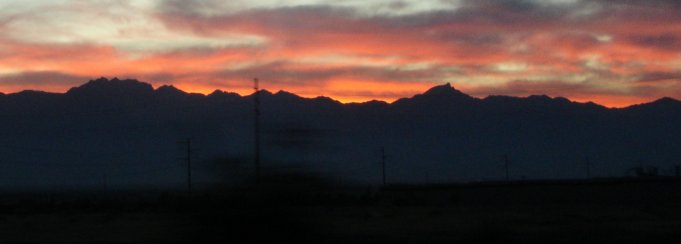
The lesson: Government intervention may be necessary to jump start alternative energy programs. A big change in infrastructure is something individual firms cannot handle alone. However, it is clear that the government can propose and encourage, but the market ultimately decides. Luck played a big role in Brazil. If the price spikes had come just a few years later, the Brazil energy program may well have been left for dead and very difficult to revive.
Fuel is important, but water is even more crucial to survival. Ironically, energy solutions such as Brazil’s use of sugar cane to make fuel will worsen water shortages. Unlike fuel, however, we do not produce water; we do not use it up. It is the ultimate renewing resource. What matters is quality and location. This renewing aspect has fooled us into thinking water is (or should be) free. Most water is not really allocated at all. In non-arid areas, we just assume there is enough water and even in arid ones, we generally give precedence to whoever is nearer or who got there first. This guarentees that water is wasted. We have to stop treating water like a free good and begin to distribute it according to market principles.
This will seem unjust. A couple years ago, I watched the Milagro Beanfield War, directed by Robert Redford. It concerns some poor farmer who steals water bought by a rich developer. It is natural to sympathize with the little guy, but if more people practiced his primitive methods it would drive everyone into poverty. He just wants to grow some beans – in the middle of the desert. He doesn’t know and the plot doesn’t openly reveal it, but he just wants to waste water, increase the salinity of his soil and ultimately make it useless. Only the free market (including rule of law, reasonable regulation & market mechanisms) will allow diverse decision making can achieve a fair result. You can still cheer for Joe Mondragon, but recognize that he is part of the problem.
The lesson: We have to look at the bigger picture and think of water as a regional, maybe even a world resource. If done properly, it can be done justly and gradually with most people given choices that improve their lives. If we pretend we can go on the old fashioned Milagro Beanfield way, everybody suffers and some people die, but somebody gets the satisfaction of “sticking it to the man.”
In the end we might have some great options from the science of biotechnology or nanotechnology. Biotechnology can produce plants that require less water, fertilizer and energy to produce greater outputs. But the connection is even more direct. Biotechnology is already contributing to the production of biofuels and may soon make the production of ethanol from cellulous faster and easier. Cellulous alcohol is the holy grail of liquid fuels. That would mean we could make fuel out waste products such as wood chips or stalks, or from easily grown and ecologically benign crops such as switchgrass. Nanotechnology may produce much better ways to capture, store and transmit energy.
Lesson: Paradigms change and we can make them change. If we think only about how things are today, we can never solve our problems. In fact, it is likely that today’s problems CANNOT be solved with today’s methods. We cannot solve problems with the same techniques that got us into them. Innovative solutions require a leap of faith, but it is a leap of faith in human intelligence and our ability to learn & adapt.
We are standing at a crossroads where our provision of energy, water and food are radically changed. These three factors will be more completely integrated than ever before. All change is difficult, but if done right this one will make all (or at least most) of us much better off and make our lifestyles more sustainable.
Brazilian Biofuels
Below is Rio. Chrissy & I went there in August, which was winter there. It doesn’t get cold and the water was pleasantly cool. It was fun playing in the waves, but I almost got sucked out by a rip tide. I tried to swim in but found myself farther and farther from land. Then I remembered to swim parallel to shore. Rip tides are like rivers; they are long but usually not wide. We didn’t see much of Brazil. This was our first post and since we were so poor paying off student loans, setting up household etc we only went where the job sent us. Fortunately, travel was a part of my job. Brazil is a beautiful and diverse country.
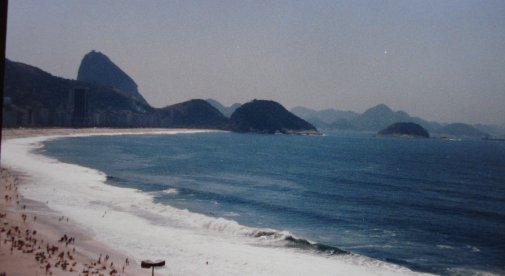
I was in Brazil when the sugar cane alcohol fuel program was just a few years old. Cities like Rio, Sao Paulo or Porto Alegre sort of smelled like a tavern, not a surprise when the cars are essentially running on rum. I was intrigued by the idea of turning sugarcane into fuel, but I admit that I wasn’t very impressed with the application back in 1985/6. Porto Alegre has a climate like Savannah, Georgia. It rarely got very cold, but it was cold enough to gum up the engines that ran on alcohol. But the Brazilians have overcome these challenges and their thirty-year experiment with alternative fuels seems to have succeeded. They have gone from importing 70%+ of their fuel for their cars to less around 10%, but there is more to the story. I went over to AEI to hear Energy Lessons from Brazil to get the update.
Below is Porto Alegre from the window of our apartment there. Rainbows like that were common.
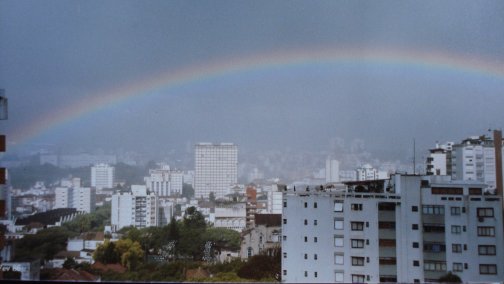
The speaker explained that the impressive figures were a little deceptive. The Brazilian success came not only from alternative fuels, but also from a lot of old fashioned oil that they discovered offshore. And that was the first lesson from Brazil – you have to do all of the above when it comes to energy.
Brazil has a big advantage in biofuels because the climate is great for growing sugarcane and sugarcane is great for making biofuel. Making fuel from sugarcane is around 8 times more efficient than from corn. In fact, corn probably uses as much or more energy to make a gallon of fuel as it yields, so corn ethanol is more just an energy carrier than source. Beyond that, sugarcane is relatively unmanipulated, i.e. there has been little crop improvement done on cane, so there more scope for easy improvement than there is in corn, which has long been the subject of selection.
Below is Brasilia. The picture is within the city. It was not carved out the jungle, as the myth says. Brasilia was mowed out of the grass. The climate is nice, with a dry season when it never rains and a wet season when it rains every day. I like the rainy season better because it gets very green. There was a lot of space in 1985. I suppose it has grown.
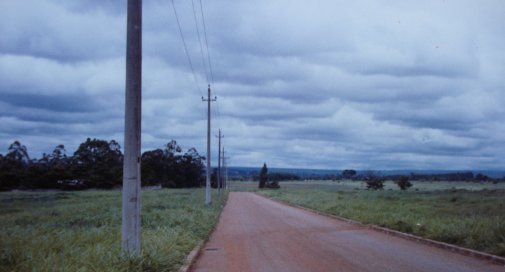
Even with all this, however, low oil prices in the 1990s almost killed the sugarcane experiment. Ethanol from sugarcane is competitive with gas when oil is around $50 a barrel. When oil gets too cheap, it drives out the alternatives, as I have written before.
Alternatives to oil are good for both political and economic reasons. Most of the world’s easily exportable oil is under or near unstable countries often in places where democracy is not viewed with particular enthusiasm. Less dependence on these sorts of places is good. In the Brazilian case (which probably in applicable generally) having the alternative to oil made the economy more stable. More than 90% of the cars sold in Brazil are flex fuel, which means drivers can choose the cheaper fuel, which moderates price changes. Besides that, the alternative fuel employs people within the country, keeping transfers at home instead of bleeding money to various petrostates.
Below is Gramado, north of Porto Alegre. Southern Brazil had a lot of immigrants from Germany and N. Italy and had a very European feel, except for the exotic trees.
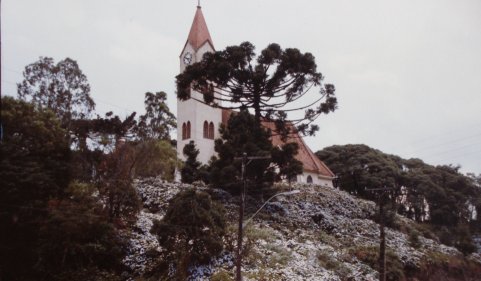
We can learn from what the Brazilians pioneered. Some of the technologies and techniques can be applied and adapted to American realities. We need to find a better feedstock than corn for our biofuels, however. I hold out hope for cellulostic ethanol, but nobody can predict the future. Ten years ago, the Brazilian ethanol experiment was floundering; today it is flourishing. In an uncertain world, you have to try all of the above with a wide portfolio of solutions … and be ready to be flexible when some of your favorites don’t work.
P.S. In the Q&A somebody got up and self righteously asked why America with around 5% of the world population should consume 25% of the world’s energy. Somebody always “asks” this question, but it is a silly question and the premise is wrong. Energy consumption is related to output. The U.S. produces around 25% of the world’s output and it consumes a commensurate amount of energy. We need to be more efficient in our use of energy, but we cannot get down to using the same % of energy as our population unless our economy collapses (and probably brings the world down with us) or others in the world catch up.

They call that energy intensity or energy efficiency. Our energy intensity has been improving for the last 40 years, but our economy is growing even faster.
Simple, Maybe not Easy
People make the right choices when they have the right incentives and they can do what they say they cannot. According to articles I read, Americans drove 112 billion FEWER miles over the past thirteen months. This is way higher than the previous biggest drop of 49.9 billion miles in the 1970s. The drops in driving are across the U.S., with Rhode Island, Utah and Vermont the top three. Wide open Utah has little in common with compact Rhode Island. The drop is rural and urban.
Below is a picture I took in Germany. English is not their native language, but I don’t think this is coincidence.

Gas consumption drops when the price rises. All the rules, CAFÉ standards and exhortations are mostly just feel good palliatives, analogous to all those fad diets beloved by fat people and largely ineffective. Solutions are simple, just not easy. Higher gas prices lead to less driving. Traffic and parking problems help in the long run. People make logical decisions. When driving in cheap and easy, they drive more. When conditions change, they do too. Bad economic conditions are evidently extending the demand drop for gasoline. Simple, but not easy – there is no painless way to achieve change.
And we do need to change. The environmental effects of carbon consumption are bad enough, but we also have the geopolitical considerations. Most of the easily exported oil is under or near countries that are unstable or run by despots and tyrants.
Anyway, the continuing drop in driving and related drop in oil consumption is a bit of good news, but we have been in this place before. This time we should do the right thing and get the incentives right. The time to raise taxes on oil is when prices are low. I have written about these things many times before. When gas prices were high, I wrote that they would drop again and that we should raise taxes on oil when they did. The time is now.
Energy

Energy independence is neither possible nor desirable. Well … it is possible for the U.S. to become energy independent. We could do it in short order if we were willing to pay the price in terms of money and environmental degradation. The U.S. has the world’s largest reserves of coal. We have the technology to extract natural gas from oil shale in our western states. Of course, we could burn wood to heat our homes.
Of course, this is not the first time I wrote about this subject. Follow this link for some of the older stuff.
The best energy policy is “all of the above.” We should have a diversity of sources and a wide choice of options. We lean too heavily on oil and especially imported oil. But if we are to address this problem, it is probably a good idea to figure out how we got here.
Why do we import oil and other sources of energy? Because it is cheaper and easier than the alternatives. It is that simple. It is not the result of mistakes or stupidity. Importing cheap oil instead of using dirtier or harder to use domestic energy makes perfect sense. Except that oil is not really as cheap as it seems.
Economists talk about external costs and benefits. When I plant trees, I personally get only a part of the benefits. The cleaner air & water as well as the wildlife & aesthetic benefits are provided free to others. When I burn a gallon of gas, I personally pay only part of the cost. The air pollution & CO2 are part of the cost I impose on others. But oil has other costs.
It seems like something of a divine joke that so much of the world’s easily accessed oil lies near or under unstable countries run by despots or other nasties that are not particularly attached to the values we hold dear. It is just not smart to be too dependent on these sorts. Oil to despots is like steroids to petty thugs. It makes them bigger. What kind of threat would Saddam have been w/o oil? He would have been a pissant dictator like Robert Mugabe – a very bad man, but just a local menace. W/o the wealth poured in by oil, most of today’s terrorists would be neighborhood bandits. W/o oil, Hugo would be a second class stand-up comic.
Anyway, a gallon of gas would cost a lot more if it included more of the expenses associated with its provision & protection, the costs of encouraging despots and terrorists as well as the pollution and CO2 it produces. I will say again, that while I am not a big believer in raising taxes, I believe in taxing gas, or more precisely carbon. This has many good knock off effects.
As I mentioned above, we burn gas for good & logical reasons. It is cheaper and easier than the alternatives. You cannot convince most people to use less gas or switch to alternatives because using gas makes sense. Many alternative fuel enthusiasts seem not to understand this and persist in thinking that they just need to explain things to the ignorant fossil fuel users. Maybe just a few more public service adverts will do the trick – not.
If you want to change the fuel mix, you have to change the incentives. Nothing works faster than price, as we saw in 2006, when gasoline consumption declined and U.S. CO2 emissions overall actually dropped. This is the first time this ever happened in a time of robust economic growth. Higher oil prices are an automatic stimulus to alternatives. Alternatives that are money losers when oil is $40, suddenly look really good when oil reaches $80. We are now seeing the reverse begin to set in as the price of gas plummets. Already drivers are putting on more miles and looking at those bigger cars and SUVs.
We have a another big chance to make a dent in the oil addiction, make our air cleaner, encourage alternatives and screw some international bad guys. If we blow it, this will be the third time. In the middle 1980s, the price of oil dropped and wiped out lots of alternative investments. In 1998, oil was at an all time low in dollars adjusted for inflation. Instead of taking advantage, we bought the big SUVs. A year ago, experts told us that we would never again see cheap oil. They were wrong. Let’s make sure not to fall into that cheap oil trap again.
We really cannot have cheap oil in the long run. The only real question is whether we pay it in American taxes and stabilize prices to some extent or pay to oil producers and tolerate wild swings that preclude the development of viable alternatives and enrich and corrupt people who don’t like us. Let’s not make Hugo, Vlad and Mahmoud any happier than necessary. Opportunities don’t last forever. This one won’t last very long.

